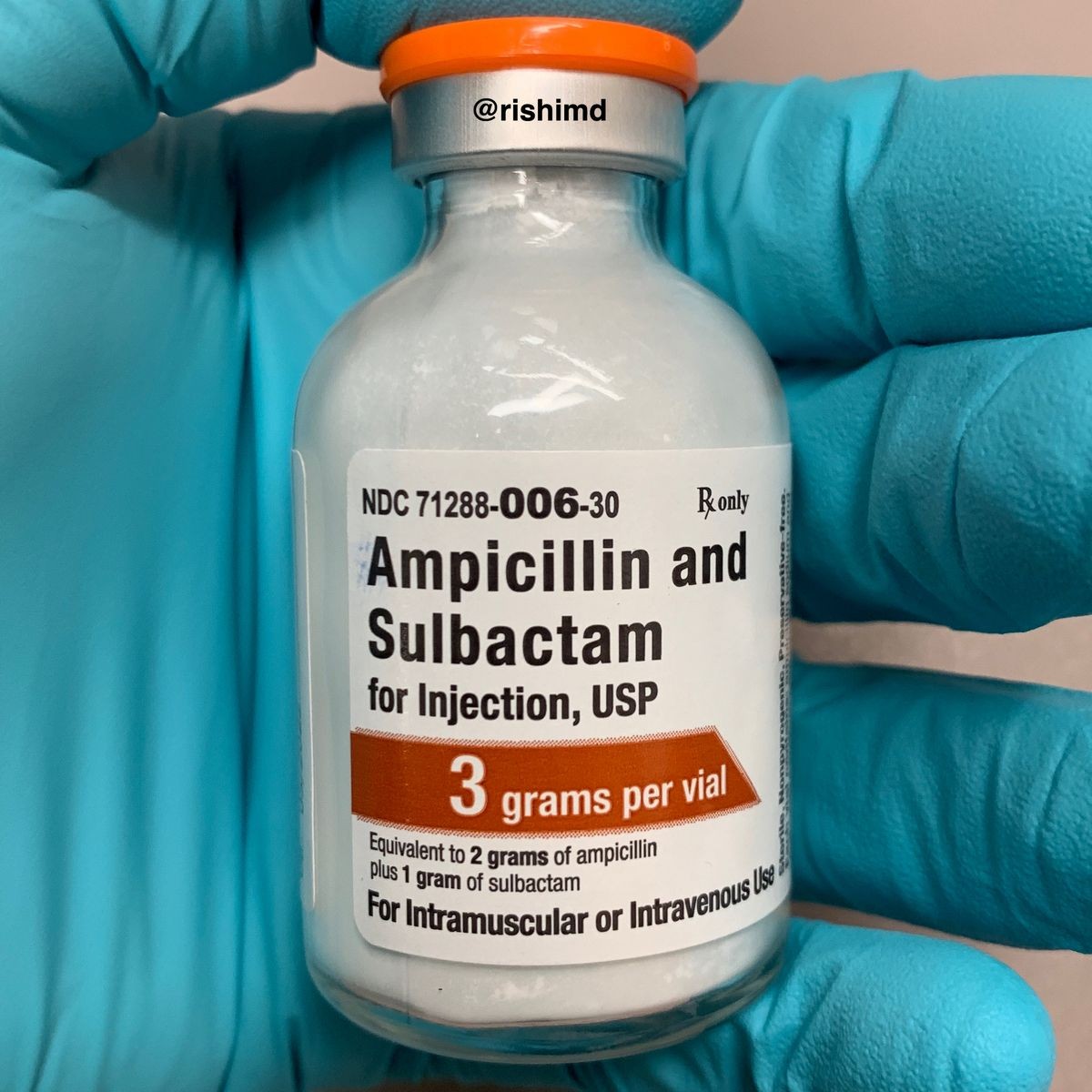
Contents
Unasyn (ampicillin and sulbactam)
Unasyn is indicated for the treatment of infections due to susceptible strains of the designated microorganisms in the following conditions:
- Skin and Skin Structure Infections caused by beta-lactamase producing strains of Staphylococcus aureus, Escherichia coli, Klebsiella spp., Proteus mirabilis, Bacteroides fragilis, Enterobacter spp, and Acinetobacter calcoaceticus.
- Intra-Abdominal Infections caused by beta-lactamase producing strains of Escherichia coli, Klebsiella spp., Bacteroides spp., and Enterobacter spp.
- Gynecological Infections caused by beta-lactamase producing strains of Escherichia coli and Bacteroides spp.
* Efficacy for this organism in this organ system was studied in fewer than 10 infections.
While Unasyn is indicated only for the conditions listed above, infections caused by ampicillin-susceptible organisms are also amenable to treatment with Unasyn due to its ampicillin content. Therefore, mixed infections caused by ampicillin-susceptible organisms and beta-lactamase producing organisms susceptible to Unasyn should not require another antibacterial.
Appropriate culture and susceptibility tests should be performed before treatment to isolate and identify the organisms causing infection and determine their susceptibility to Unasyn.
Therapy may be instituted prior to obtaining results from bacteriological and susceptibility studies when there is reason to believe the infection may involve any of the beta-lactamase producing organisms listed above in the indicated organ systems. Once the results are known, therapy should be adjusted if appropriate.
To reduce the development of drug-resistant bacteria and maintain the effectiveness of Unasyn and other antibacterial drugs, Unasyn should be used only to treat infections proven or strongly suspected to be caused by susceptible bacteria.
When culture and susceptibility information are available, they should be considered in selecting or modifying antibacterial therapy. In the absence of such data, local epidemiology and susceptibility patterns may contribute to the empiric selection of therapy.
What are the side effects of Unasyn?
To reduce the development of drug-resistant bacteria and maintain the effectiveness of Unasyn and other antibacterial drugs, Unasyn should be used only to treat infections proven or strongly suspected to be caused by bacteria.
What is the dosage for Unasyn?
- Unasyn may be administered by the IV or the IM routes.
- For IV administration, the dose can be given by slow intravenous injection over at least 10-15 minutes or can also be delivered in greater dilutions with 50-100 mL of a compatible diluent as an intravenous infusion over 15-30 minutes.
- Unasyn may be administered by deep intramuscular injection.
- The recommended adult dosage of Unasyn is 1.5 g (1 g ampicillin as the sodium salt plus 0.5 g sulbactam as the sodium salt) to 3 g (2 g ampicillin as the sodium salt plus 1 g sulbactam as the sodium salt) every six hours.
- This 1.5 to 3 g range represents the total ampicillin content plus the sulbactam content of Unasyn, and corresponds to a range of 1 g ampicillin/0.5 g sulbactam to 2 g ampicillin/1 g sulbactam. The total dose of sulbactam should not exceed 4 grams per day.
Pediatric Patients 1 Year Of Age Or Older
- The recommended daily dose of Unasyn in pediatric patients is 300 mg per kg of body weight administered via intravenous infusion in equally divided doses every 6 hours.
- This 300 mg/kg/day dosage represents the total ampicillin content plus the sulbactam content of Unasyn, and corresponds to 200 mg ampicillin/100 mg sulbactam per kg per day.
- The safety and efficacy of Unasyn administered via intramuscular injection in pediatric patients have not been established. Pediatric patients weighing 40 kg or more should be dosed according to adult recommendations, and the total dose of sulbactam should not exceed 4 grams per day.
- The course of intravenous therapy should not routinely exceed 14 days.
- In clinical trials, most children received a course of oral antimicrobials following initial treatment with intravenous Unasyn.
Impaired Renal Function
- In patients with impairment of renal function, the elimination kinetics of ampicillin and sulbactam are similarly affected, hence the ratio of one to the other will remain constant regardless of renal function.
- The dose of Unasyn in such patients should be administered less frequently in accordance with the usual practice for ampicillin and according to the following recommendations:
TABLE 5 Unasyn Dosage Guide for Patients with Renal Impairment
| Creatinine Clearance (mL/min/1.73m 2 ) | Ampicillin/Sulbactam Half-Life (Hours) | Recommended Unasyn Dosage |
| ≥30 | 1 | 1.5-3 g q 6h-q 8h |
| 15-29 | 5 | 1.5-3 g q 12h |
| 5-14 | 9 | 1.5-3 g q 24h |
When only serum creatinine is available, the following formula (based on sex, weight, and age of the patient) may be used to convert this value into creatinine clearance. The serum creatinine should represent a steady state of renal function.
| Males: | (weight in kg) x (140 – age) |
| (72) x serum creatinine (mg/100 mL) | |
| Females: | (0.85) x (above value) |
Compatibility, Reconstitution And Stability
- Unasyn sterile powder is to be stored at or below 30°C (86°F) prior to reconstitution.
- When concomitant therapy with aminoglycosides is indicated, Unasyn and aminoglycosides should be reconstituted and administered separately due to the in vitro inactivation of aminoglycosides by any of the aminopenicillins.
What drugs interact with Unasyn?
- Probenecid decreases the renal tubular secretion of ampicillin and sulbactam.
- Concurrent use of probenecid with Unasyn may result in increased and prolonged blood levels of ampicillin and sulbactam.
- The concurrent administration of allopurinol and ampicillin substantially increases the incidence of rashes in patients receiving both drugs compared to patients receiving ampicillin alone.
- It is not known whether this potentiation of ampicillin rashes is due to allopurinol or the hyperuricemia present in these patients.
- There are no data with Unasyn and allopurinol administered concurrently.
- Unasyn and aminoglycosides should not be reconstituted together due to the in vitro inactivation of aminoglycosides by the ampicillin component of Unasyn.
Is Unasyn safe to use while pregnant or breastfeeding?
- Reproduction studies have been performed in mice, rats, and rabbits at doses up to ten (10) times the human dose and have revealed no evidence of impaired fertility or harm to the fetus due to Unasyn.
- There are, however, no adequate and well-controlled studies in pregnant women.
- Because animal reproduction studies are not always predictive of human response, this drug should be used during pregnancy only if clearly needed. Low concentrations of ampicillin and sulbactam are excreted in the milk; therefore, caution should be exercised when Unasyn is administered to a nursing woman.
Summary
Unasyn is indicated for the treatment of infections due to susceptible strains of the designated microorganisms in conditions such as skin and skin structure infections, intra-abdominal infections, and gynecological infections.


